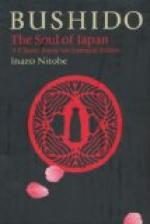And yet, for a true samurai to hasten death or to court it, was alike cowardice. A typical fighter, when he lost battle after battle and was pursued from plain to hill and from bush to cavern, found himself hungry and alone in the dark hollow of a tree, his sword blunt with use, his bow broken and arrows exhausted—did not the noblest of the Romans fall upon his own sword in Phillippi under like circumstances?—deemed it cowardly to die, but with a fortitude approaching a Christian martyr’s, cheered himself with an impromptu verse:
“Come! evermore come,
Ye dread
sorrows and pains!
And heap on my burden’d
back;
That I not
one test may lack
Of what strength in
me remains!”
This, then, was the Bushido teaching—Bear and face all calamities and adversities with patience and a pure conscience; for as Mencius[20] taught, “When Heaven is about to confer a great office on anyone, it first exercises his mind with suffering and his sinews and bones with toil; it exposes his body to hunger and subjects him to extreme poverty; and it confounds his undertakings. In all these ways it stimulates his mind, hardens his nature, and supplies his incompetencies.” True honor lies in fulfilling Heaven’s decree and no death incurred in so doing is ignominious, whereas death to avoid what Heaven has in store is cowardly indeed! In that quaint book of Sir Thomas Browne’s, Religio Medici there is an exact English equivalent for what is repeatedly taught in our Precepts. Let me quote it: “It is a brave act of valor to contemn death, but where life is more terrible than death, it is then the truest valor to dare to live.” A renowned priest of the seventeenth century satirically observed—“Talk as he may, a samurai who ne’er has died is apt in decisive moments to flee or hide.” Again—Him who once has died in the bottom of his breast, no spears of Sanada nor all the arrows of Tametomo can pierce. How near we come to the portals of the temple whose Builder taught “he that loseth his life for my sake shall find it!” These are but a few of the numerous examples which tend to confirm the moral identity of the human species, notwithstanding an attempt so assiduously made to render the distinction between Christian and Pagan as great as possible.
[Footnote 20: I use Dr. Legge’s translation verbatim.]
We have thus seen that the Bushido institution of suicide was neither so irrational nor barbarous as its abuse strikes us at first sight. We will now see whether its sister institution of Redress—or call it Revenge, if you will—has its mitigating features. I hope I can dispose of this question in a few words, since a similar institution, or call it custom, if that suits you better, has at some time prevailed among all peoples and has not yet become entirely obsolete, as attested by the continuance of duelling and lynching. Why, has not an American captain recently challenged Esterhazy, that the wrongs




